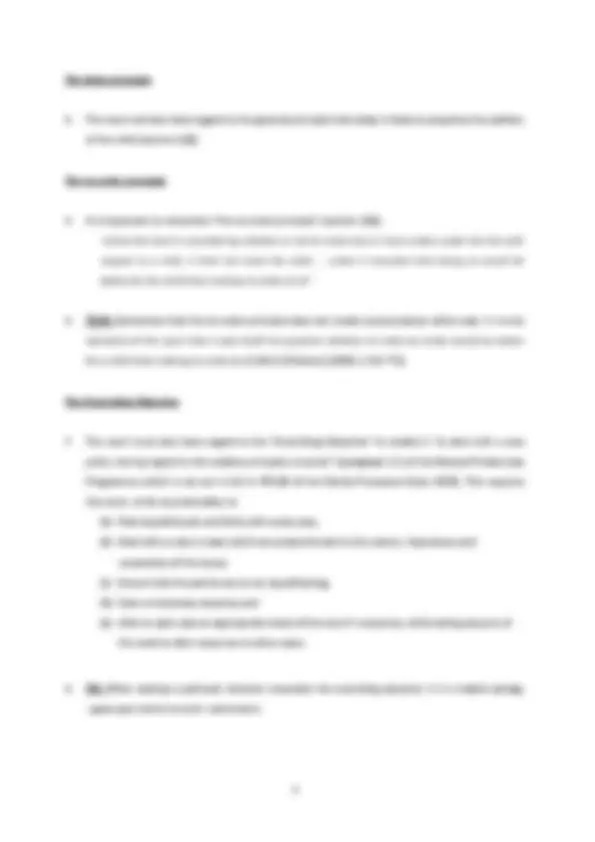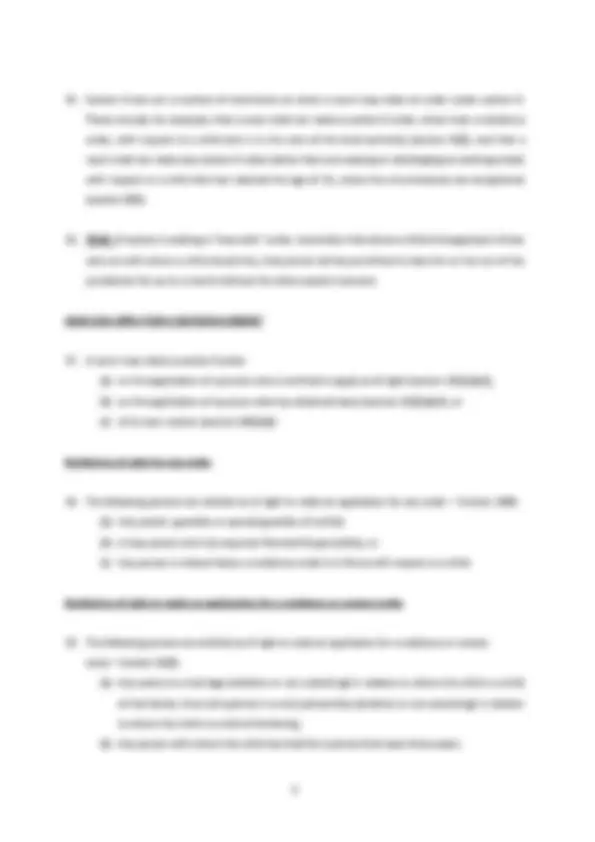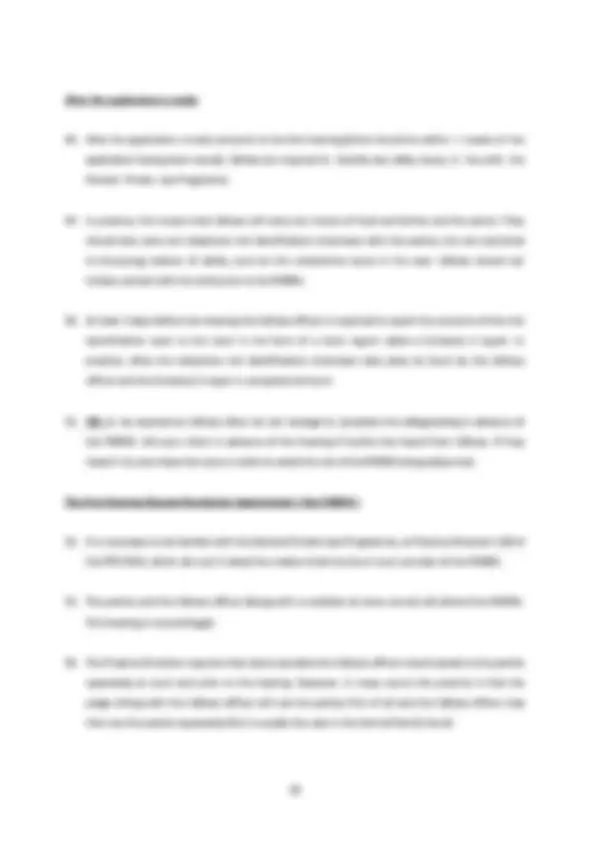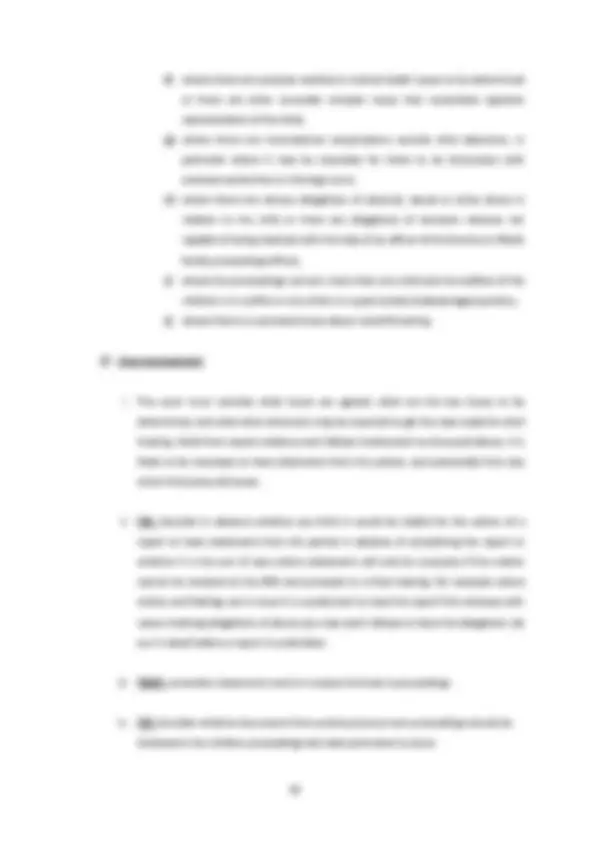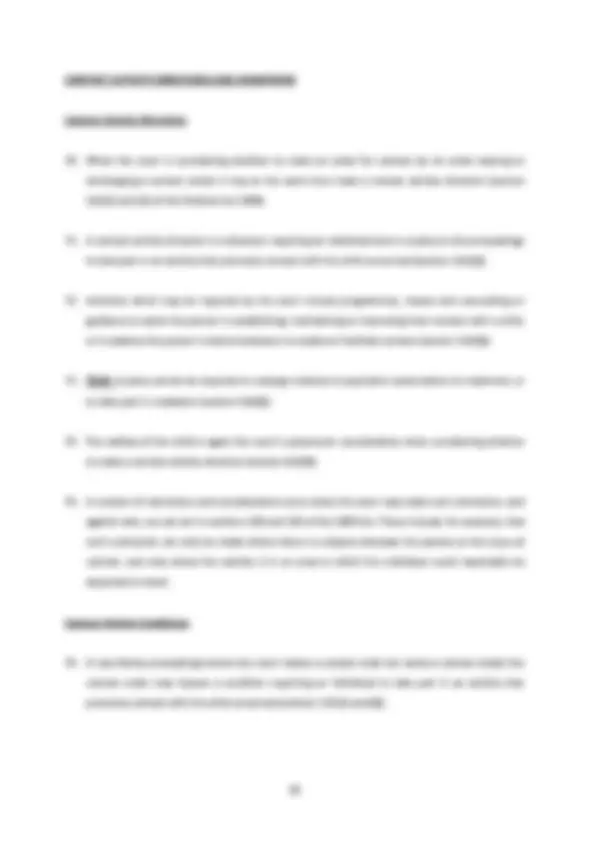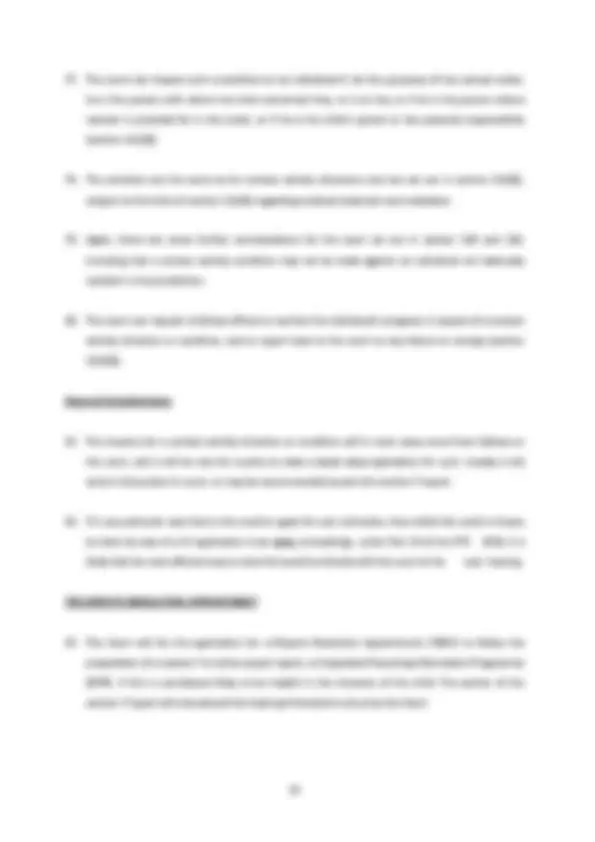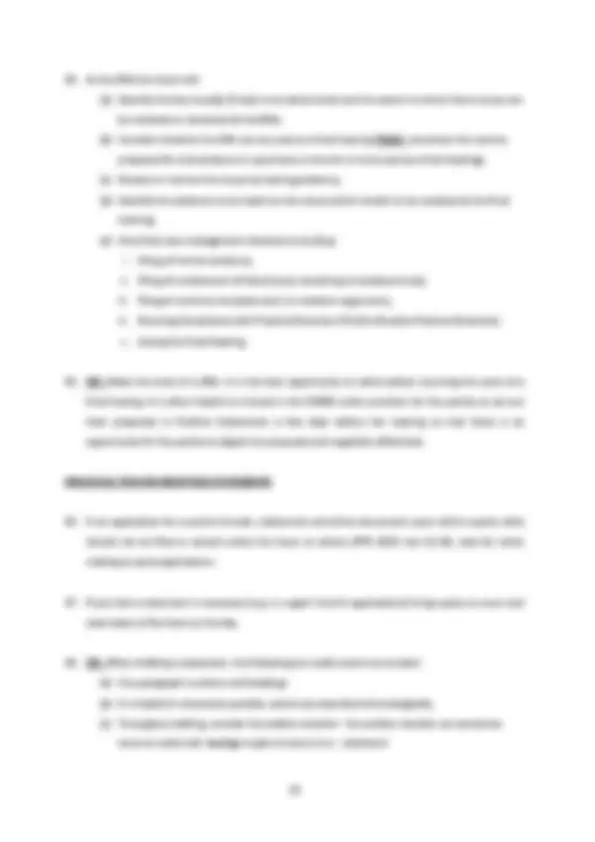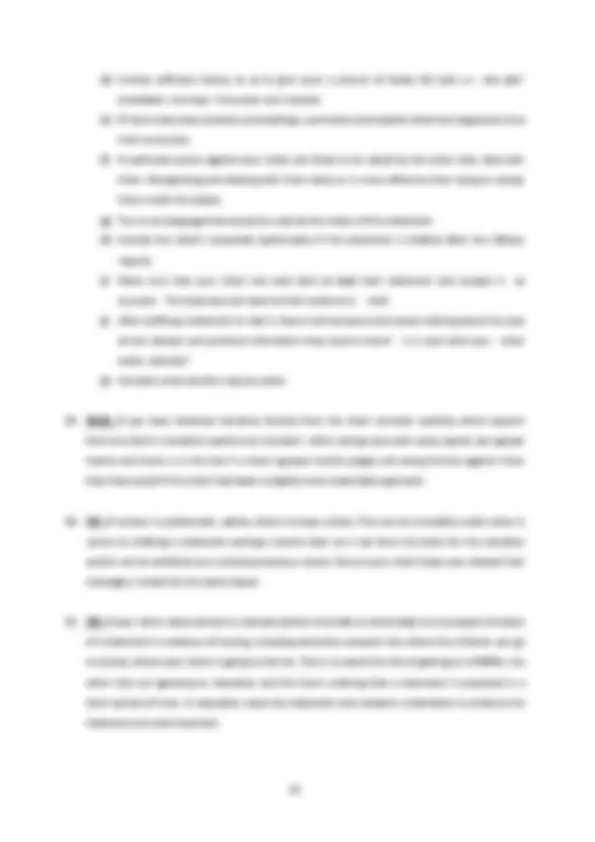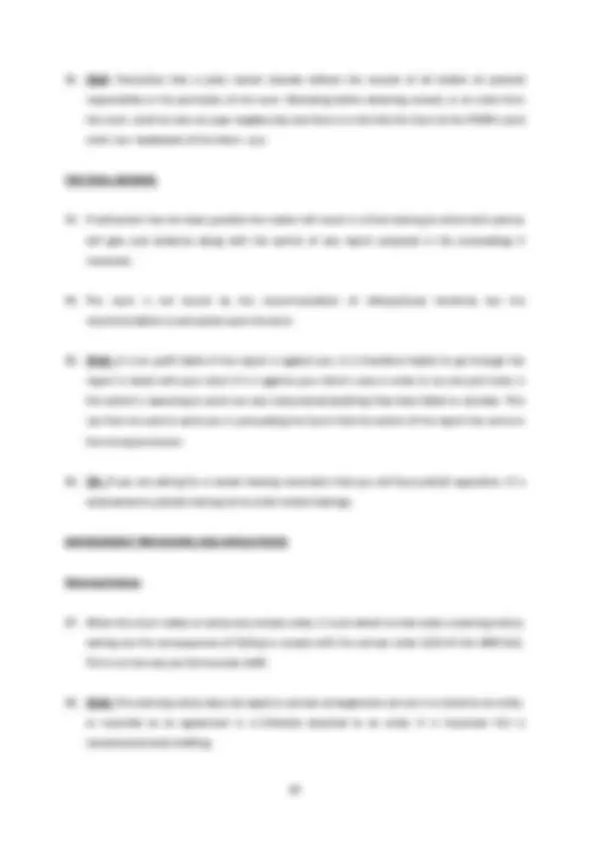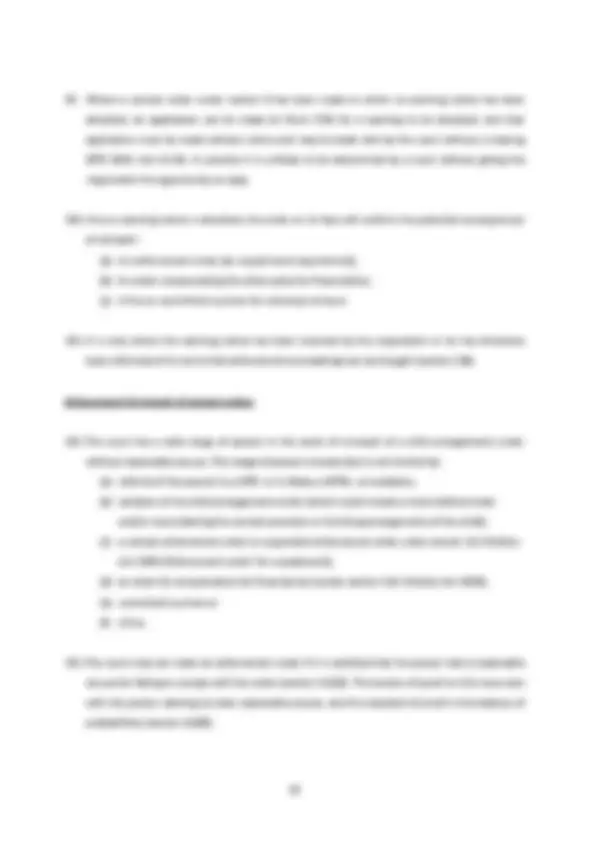Download Making Private Law Children Act Applications: Orders, Procedures, and Considerations and more Study notes Private law in PDF only on Docsity!
SECTIONS 8 AND 11
OF THE CHILDREN ACT 1989
Procedure, tips and traps
CHARLOTTE TRACE
29 Bedford Row
17 March 2016
(ctrace@29br.co.uk)
These notes deal with making private law Children Act applications, principally applications under section 8 of the Act (namely for contact, residence, specific issue and prohibited steps orders) but also with applications under section 11 for contact activity directions and conditions, and for enforcement. They do not deal with more specialist applications, such as those relating to child abduction or those relating to financial provision under Schedule 1 to the Children Act 1989, to which different procedural rules apply.
THE BASIC PRINCIPLES
- The fundamental principles are set out in section 1 of the Children Act 1989. You must have these in mind whenever you are making any application under the Act. They act as the wide “umbrella” under which the court will exercise its discretion when deciding what orders to make.
The Paramountcy Principle
- The fundamental principle is found in section 1(1) of the Children Act 1989: “When a court determines any question with respect to – (a) The upbringing of a child; or (b) The administration of a child’s property or the application of any income arising from it, the child’s welfare shall be the court’s paramount consideration.”
The Welfare checklist
- In all applications under section 8 of the Act, the court will have regard to the welfare checklist (section 1(3)): (a) The ascertainable wishes and feelings of the child (considered in the light of his age and understanding); (b) His physical, emotional and education needs; (c) The likely effect on the child of any change in circumstances; (d) His age, sex, background and any other relevant characteristics. (e) Any harm suffered or at risk of being suffered; (f) The capability of parents and other relevant persons to meet the child’s needs; and (g) The range of powers available to the court.
- TRAP: Remember there is a basic presumption that both parents should be involved in a child’s life unless that involvement would not further the children’s welfare. It is important when writing about child arrangements to remember that a child has a right to contact rather than one parent having the power to “permit” or “deny” contact. Phraseology can be revealing.
- TRAP: Remember to advise your client about Parental Responsibility (‘PR’) and the need to not act unilaterally. Remind your client that decisions about issues such as the child’s medical treatment, name and schooling need to be agreed between both parents and if it cannot be agreed then a specific issue application needs to be made. Remind the parent with whom the child lives that he/she needs to keep the other parent updated about the child.
- A mother automatically has PR from birth, a father will usually have PR if named on the birth certificate or married to the child’s mother. In terms of births registered in England and Wales if the parties were married when the child is born or if they’ve jointly adopted a child then they both have PR. An unmarried father can get PR in 1 of 3 ways: (a) jointly registering the birth of the child with the mother (from 1 December 2003); (b) getting a parental responsibility agreement with the mother; (c) getting a parental responsibility order from a court.
- Same sex partners will both have PR if they were civil partners at the time of the treatment (eg donor insemination or fertility treatment). If same sex partners are not civil partners the second parent can obtain PR by: (a) applying for PR if a parental agreement was made; or (b) becoming a civil partner of the other parent and making a parental responsibility agreement or jointly registering the birth.
THE RANGE OF ORDERS THE COURT CAN MAKE UNDER SECTION 8
- The court may make 4 types of order under section 8: (a) Contact orders; (b) Prohibited steps orders; (c) Residence orders (or shared residence orders); (d) Specific issue orders.
- The considerations for the court when deciding whether to make any of the above orders are those set out in section 1 of the Children Act, specifically sections 1(1) and 1(3) – at paragraphs 2 and 3 above.
- Section 9 sets out a number of restrictions on when a court may make an order under section 8. These include, for example, that a court shall not make a section 8 order, other than a residence order, with respect to a child who is in the care of the local authority (section 9(1)), and that a court shall not make any section 8 order (other than one varying or discharging an existing order) with respect to a child who has reached the age of 16, unless the circumstances are exceptional (section 9(7)).
- TRAP: If a party is seeking a “lives with” order, remember that where a Child Arrangements Order sets out with whom a child should live, that person will be permitted to take him or her out of the jurisdiction for up to a month without the other parent's consent.
WHO CAN APPLY FOR A SECTION 8 ORDER?
- A court may make a section 8 order: (a) on the application of a person who is entitled to apply as of right (section 10(1)(a)(i); (b) on the application of a person who has obtained leave (section 10(1)(a)(ii); or (c) of its own motion (section 10(1)(b)).
Entitled as of right for any order
- The following persons are entitled as of right to make an application for any order - Section 10(4): (a) Any parent, guardian or special guardian of a child; (b) A step -- parent who has acquired Parental Responsibility; or (c) Any person in whose favour a residence order is in force with respect to a child.
Entitled as of right to make an application for a residence or contact order
- The following persons are entitled as of right to make an application for a residence or contact order - Section 10(5): (a) Any party to a marriage (whether or not subsisting) in relation to whom the child is a child of the family / Any civil partner in a civil partnership (whether or not subsisting) in relation to whom the child is a child of the family; (b) Any person with whom the child has lived for a period of at least three years;
- The application should generally be made in the court local to where the child lives. This is for reasons of convenience for the child (and arguably also for the primary carer), but also because any CAFCASS involvement will require a CAFCASS officer to be appointed from the branch local to the child.
- If the applicant believes that the child has suffered or is at risk of suffering any harm from domestic violence, violence within the household, child abduction or other conduct or behaviour by any person who has had contact with the child then a Form C1A should also be completed, summarising the harm suffered and the risks envisaged.
- TRAP: Make sure a Form C1A is filed when the application is made (or when a C7 response is filed) if your client is contending that domestic abuse is relevant. It is very difficult to raise and rely upon allegations later if a C1A has not been filed.
- TRAP: Do not file a statement at the time of issuing your application (unless it is an urgent ex parte application).
- TIP: Focus on the application itself. The Court will not have any statements so the application is a key document at the first hearing. Make sure it is carefully composed.
- An application for leave to apply for an application must be made on Form C2 and be accompanied by a draft of the application for which leave is sought (on a Form C100).
- If your client wishes to withhold his/her address from the other party, he or she must complete a Form C8 and file this at the same time as the main application.
Service of the application
- The rules relating to Service of the Application are set out in the FPR 2010 at Practice Direction 12C.
- The Applicant must serve a copy of the application (together with Forms C6 and C7) on each Respondent at least 14 days before the first hearing, the First Hearing Dispute Resolution
Appointment (‘FHDRA’), the date for which will be set by the court and notified to the applicant or his solicitors.
- The Applicant must also serve the application with Form C6A on any non-parties who should be given notice (for example, persons caring for the child at the time the application is made).
- The rules as to what constitutes service are set out in Part 6 of the FPR 2010, specifically at rules 6.23–6.39 (rule 6.36 provides for the court’s power to dispense with service). The court also retains the power to abridge time for service (PD12 paragraph 3.5).
- Applications for leave to apply for a section 8 order are governed by Part 18 of the FPR 2010 and the procedure set out therein. Once leave is granted, the procedure under Part 12 as summarised above comes into play.
Responding to an application
- Within 14 days of service of the application, the Respondent must file and serve an acknowledgement of the application in Form C7 (and C1A if appropriate). (FPR 2010 rule 12.32). Again, do not file a statement at this stage.
Ex parte applications
- An application for a section 8 order may be made ex parte (FPR 2010 rule 12.16). In the Family Division of the High Court, an application can be made out of hours in urgent cases (tel. 020 7947 6000).
- You must file the application at the time the application is made, or where made by telephone, the next business day after making the application (rule 12.16(2)).
- The application must be made on sworn evidence (i.e. by affidavit) which must explain why it was necessary to apply ex parte.
After the application is made
- After the application is made and prior to the first hearing (which should be within 4- 6 weeks of the application having been issued), Cafcass are required to identify any safety issues, in line with the Revised Private Law Programme.
- In practice, this means that Cafcass will carry out checks of local authorities and the police. They should also carry out telephone risk identification interviews with the parties, but are restricted to discussing matters of safety, and not the substantive issues in the case. Cafcass should not initiate contact with the child prior to the FHDRA.
- At least 3 days before the hearing the Cafcass officer is required to report the outcome of the risk identification work to the court in the form of a short report called a Schedule 2 report. In practice, often the telephone risk identification interviews take place at Court by the Cafcass officer and the Schedule 2 report is completed at Court.
- TIP: In my experience Cafcass often do not manage to complete the safeguarding in advance of the FHDRA. Ask your client in advance of the hearing if he/she has heard from Cafcass. If they haven’t try and chase the issue in order to avoid the risk of the FHDRA being adjourned.
The First Hearing Dispute Resolution Appointment (‘the FHDRA’)
- It is necessary to be familiar with the Revised Private Law Programme, at Practice Direction 12B of the FPR 2010, which sets out in detail the matters that the Court must consider at the FHDRA.
- The parties and the Cafcass officer (along with a mediator at some courts) will attend the FHDRA. This hearing is not privileged.
- The Practice Direction requires that where possible the Cafcass officer should speak to the parties separately at court and prior to the hearing. However, in many courts the practice is that the judge sitting with the Cafcass officer will see the parties first of all and the Cafcass officer may then see the parties separately (this is usually the case in the Central Family Court).
- TIP: Be prepared in advance of the FHDRA.
- TRAP: Some FHDRAs are now listed before a legal advisor (for example the West London family court). Make sure you advise your client of this because it means not very much can happen at that stage as legal advisors are not the decision makers.
- The court must consider the following matters at the FHDRA:
(a) Safeguarding and fact --‐finding considerations
i. The court must inform the parties of the results of the checks carried out by Cafcass and consider whether a risk assessment is required and whether a fact-finding hearing is required to determine any allegations which are likely to affect the court’s decision.
ii. TRAP: The Court cannot allow an order to be made by agreement or an application to be withdrawn unless both parties are at court, the initial safeguarding checks have been obtained and the Cafcass officer has spoken to the parties separately. The importance of the safety checks is emphasised in judicial training and no welfare decision can be made without them.
iii. TIP: It is important to establish at an early stage with your client whether you are contending that domestic abuse is a relevant consideration. If it is, consider whether a separate fact-finding hearing is necessary or whether it can be combined with the final hearing of the substantive issues. Consider whether evidence from the police and/or health services is necessary. If police evidence is necessary, follow the Police Disclosure Protocol in the first instance.
iv. When considering whether a separate fact-finding hearing is necessary, regard must be had to the President’s Practice Direction of 14th^ January 2009 (set out in full at PD12J of the FPR 2010) and also to the President’s Guidance on split hearings of May
- The May 2010 Guidance provides that it will be a rare case in which a separate fact- finding hearing is necessary.
(d) Reports
i. It is necessary to consider whether there are any welfare issues or other considerations which should be addressed in a report by Cafcass or the Local Authority. If a report is ordered, it should be directed towards specific issues and the court should state in the order the factual and other issues that are to be addressed.
ii. TRAP: It is important to consider whether a section 7 report really is necessary. Are there any welfare issues or issues concerning the children’s wishes and feelings that require a report? Bear in mind that there will be a substantial delay before a report can be produced (typically 16 weeks and longer in some areas) and Cafcass have limited resources so the Court is unlikely to order a section 7 report unless there are genuine reasons for doing so. Sometimes it will be appropriate to simply list the matter for a Final Hearing in circumstances where parents cannot agree and there are no welfare concerns.
iii. TIP: It may, in some cases, be more appropriate for the Local Authority to produce the section 7 report, for example if they have already had significant involvement with the family. This is often considerably quicker. If the funds are available for the parties to pay privately, an independent social worker is likely to be able to report much quicker.
iv. TRAP: The court must consider whether there is a need for an investigation by the relevant local authority under section 37 of the Children Act (to consider whether it is necessary to instigate care proceedings). Client’s who allege abuse and risk of harm to the child should be warned that the Court can order a section 37 report of it’s own initiative.
v. The court will also need to consider whether any expert evidence is required. Do you need drugs/alcohol tests? Psychiatric or psychological reports? An independent social worker? What would the costs of those reports be? If you are likely to be requesting an expert report you must comply with the requirements of Practice Direction 25C of the FPR 2010 in preparation for the FHDRA (see below for details in relation to Part 25).
(e) Wishes and feelings of the child
i. It is necessary to consider how the wishes and feelings of the child are to be ascertained (if at all). This can be done at an early stage if the child is aged 9 or above, at which age they are usually invited to attend the FHDRA and speak with Cafcass away from both parents. Otherwise wishes and feelings can be ascertained as part of a full section 7 report, or by way of a (quicker) wishes and feelings report which involves only a short meeting with Cafcass, and no overall assessment of the merits of the application itself.
ii. It is also important to consider whether the child needs to be separately represented and joined as a party. Separate representation of children can be ordered where it is in the child’s best interests (rule 16.2(1)), and guidance is given at FPR 2010 Practice Direction 16A, paragraphs 7.1 to 7.5, as to when this may be appropriate. 7.2 is as follows:
The decision to make the child a party will always be exclusively that of the court, made in the light of the facts and circumstances of the particular case. The following are offered, solely by way of guidance, as circumstances which may justify the making of such an order: (a) where an officer of the Service or Welsh family proceedings officer has notified the court that in the opinion of that officer the child should be made a party; (b) where the child has a standpoint or interest which is inconsistent with or incapable of being represented by any of the adult parties; (c) where there is an intractable dispute over residence or contact, including where all contact has ceased, or where there is irrational but implacable hostility to contact or where the child may be suffering harm associated with the contact dispute; (d) where the views and wishes of the child cannot be adequately met by a report to the court; (e) where an older child is opposing a proposed course of action;
v. The court must further consider whether there are any interim orders which can usefully be made. This might involve orders for supervised, supported or indirect contact. TIP: It is useful therefore to have made enquiries of contact centre availability prior to coming to court (particularly if you are acting for the party seeking contact at a contact centre as it will then reduce the delay before your client can have contact). It may be necessary in some cases to ask the court to list an interim contact hearing where matters have not been capable of agreement at the FHDRA.
(g) Transfer
i. The Revised Private Law Programme provides that the County Court should transfer the application to the Family Proceedings Court unless one of the following exceptions applies (Allocation and Transfer of Proceedings Order, articles 15 and 16). Some courts are more proactive as regards transfer than others, but it is useful to have your arguments in order on this point before going to court: (a) The proceedings can be determined more speedily in the County Court; (b) there is a real possibility of difficulty in resolving conflicts in the evidence of witnesses; (c) there is a real possibility of a conflict in the evidence of two or more experts; (d) there is a novel or difficult point of law; (e) there are proceedings concerning the child in another jurisdiction or there are international law issues; (f) there is a real possibility that enforcement proceedings may be necessary and the method of enforcement or the likely penalty is beyond the powers of a magistrates’ court; (g) there is a real possibility that a guardian will be appointed; (h) there is a real possibility that a party to proceedings is a person lacking capacity within the meaning of the Mental Capacity Act 2005 to conduct the proceedings; or (i) there is another good reason for the proceedings to be transferred.
ii. TRAP: Sometimes a District Judge is desired because in practice they tend to take a more robust approach and are braver in terms of disagreeing with Cafcass’
recommendations etc. However, remember unless there is a good reason to transfer it is difficult to seek to transfer from the magistrates to a District Judge. The Courts are increasingly keen to keep private children disputes before a lay bench. The client needs to be advised of this.
The order at the FHDRA
- The order should set out: (a) The issues about which the parties are agreed; (b) The issues that remain to be resolved; (c) The steps that are planned to resolve the issues; (d) Any interim arrangements pending such resolution, including arrangements for the involvement of children; (e) The timetable for such steps and, where this involves further hearings, the date of such hearings; (f) A statement as to any facts relating to risk or safety; in so far as they are resolved the result will be stated and, in so far as not resolved, the steps to be taken to resolve them will be stated; (g) If it be the case, the fact of the transfer of the case to the Family Proceedings Court with the date and purpose of the next hearing; (h) If it be the case, the fact the case cannot be transferred to the FPC and the reason for the decision; (i) Whether the parties are to be assisted by participation in mediation, Parenting Information Programmes or other types of parenting intervention and to detail any contact activity directions or conditions imposed by the court.
- New CAP pro-forma orders have been issued called “CAP Master Orders” (you should have one attached to this hand-out - please do not hesitate to email me if you are unable to find the pro- formas online and I will send them to you) – fortunately they are less clunky than the previous CAP forms!
- TIP: Try to draft the order at Court with the other side at Court. This will save time and costs and if there are any drafting issues the Court can be asked to adjudicate on those issues.
- A Part 25 application should be made using the Part 18 application (attaching a draft order) - it is a form FP2. The application needs to state the following: (a) The field in which the expert evidence is required; (b) The names of suggested experts; (c) The issues to which the expert evidence is to relate; (d) Whether the evidence can be obtained from a single joint expert; (e) The matters set out in PD 25C and D; (f) What the questions for the expert will cover.
- The following Practice Directions are particularly helpful: (a) PD25A deals with experts and assessors in family proceedings; (b) PD25B sets out the duties of the expert, the expert’s report and the arrangements for an expert to attend court. (c) PD25C sets out the detail that applies to instructions in children cases. TIP: this PD includes sample questions approved by the Family Justice Council for the instruction of a child mental health professional/paediatrician and for adult psychiatrists
- TIP: The application should be made in advance of the FHDRA. However, if there is insufficient time to file an application notice in advance, inform the court and the other party as soon as possible (if possible in writing) of the nature of the application and the reason for it and provide the Court with as much of the info referred to in FPR 25.7 and PD25D 3.11. Then make an oral application at the hearing. (N.B. An oral application of this kind should be the exception reserved for genuine cases where circumstances are such that it has only become apparent shortly before the hearing that an expert opinion is necessary)
- TIP: Ensure you are as prepared as you can be (with CVs and costs estimates etc) in advance of the FHDRA to argue for an expert. Remember the Court views Social Workers and Cafcass officers as experts.
CONTACT ACTIVITY DIRECTIONS AND CONDITIONS
Contact Activity Directions
- When the court is considering whether to make an order for contact (or an order varying or discharging a contact order) it may at the same time make a contact activity direction (section 11A(1) and (2) of the Children Act 1989).
- A contact activity direction is a direction requiring an individual who is a party to the proceedings to take part in an activity that promotes contact with the child concerned (section 11A(3)).
- Activities which may be required by the court include programmes, classes and counselling or guidance to assist the person in establishing, maintaining or improving their contact with a child, or to address the person’s violent behaviour to enable or facilitate contact (section 11A(5)).
- TRAP: A party cannot be required to undergo medical or psychiatric examination or treatment, or to take part in mediation (section 11A(6)).
- The welfare of the child is again the court’s paramount consideration when considering whether to make a contact activity direction (section 11A(9)).
- A number of restrictions and considerations as to when the court may make such a direction, and against who, are set out in sections 11B and 11E of the 1989 Act. These include, for example, that such a direction can only be made where there is a dispute between the parties on the issue of contact, and only where the activity is in an area to which the individual could reasonably be expected to travel.
Contact Activity Conditions
- In any family proceedings where the court makes a contact order (or varies a contact order) the contact order may impose a condition requiring an individual to take part in an activity that promotes contact with the child concerned (section 11C(1) and (2)).

